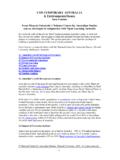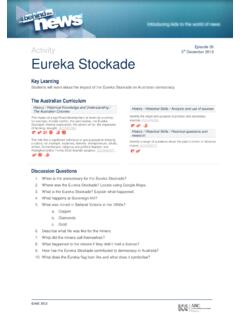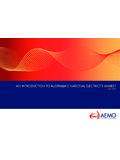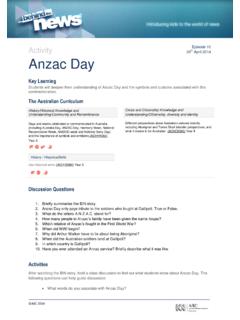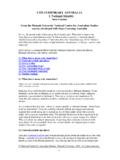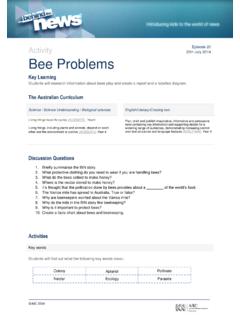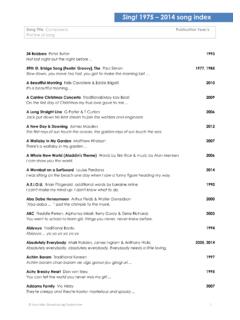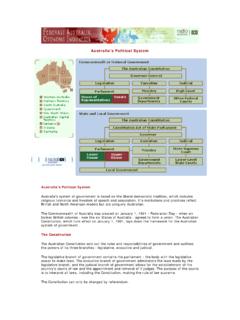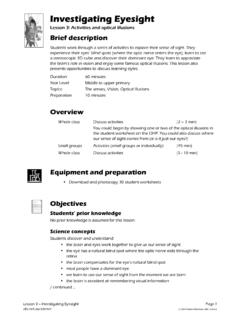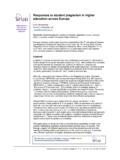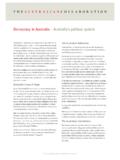Transcription of Convergence Review - ABC
1 Convergence ReviewFinal ReportConvergence Review Final ReportMarch 2012 Commonwealth of australia 2012 ISBN:978-0-642-75430-1 (PDF)978-0-642-75431-8 (doc)978-0-642-75432-5 (print)The Convergence Review Final Report is protected by the exception of the Commonwealth Coat of Arms and where otherwise noted, all material included this report is licensed under a Creative Commons Attribution australia licence ( ).The details of the relevant licence conditions are available on the Creative Commons website, as is the full legal code for CC BY AU licence ( ).The document must be attributed as the Convergence Review : Final Report. Using the Commonwealth Coat of Arms The terms of use for the Coat of Arms are available from Other useThe use of any material in this report in a way not permitted or otherwise allowed under the Copyright Act 1968 may be an infringement of copyright. Where you wish to use the material in this report in a way that is beyond the scope of the terms of use that apply to it, you must lodge a request for further authorisation with the address requests and inquiries concerning further authorisation to:Department of Broadband, Communications and the Digital Economy PO Box 2154 Canberra ACT 2601 Commonwealth of australia 2012 ISBN:978-0-642-75430-1 (PDF)978-0-642-75431-8 (doc)978-0-642-75432-5 (print)The Convergence Review Final Report is protected by the exception of the Commonwealth Coat of Arms and where otherwise noted, all material included this report is licensed under a Creative Commons Attribution australia licence ( ).
2 The details of the relevant licence conditions are available on the Creative Commons website, as is the full legal code for CC BY AU licence ( ).The document must be attributed as the Convergence Review : Final Report. Using the Commonwealth Coat of Arms The terms of use for the Coat of Arms are available from Other useThe use of any material in this report in a way not permitted or otherwise allowed under the Copyright Act 1968 may be an infringement of copyright. Where you wish to use the material in this report in a way that is beyond the scope of the terms of use that apply to it, you must lodge a request for further authorisation with the address requests and inquiries concerning further authorisation to:Department of Broadband, Communications and the Digital Economy PO Box 2154 Canberra ACT 2601 of transmittal ..iiiExecutive summary ..vii1. The need for a new approach ..12. Media ownership ..183. Content-related competition issues.
3 284. Content standards ..375. Australian content: screen ..596. Australian content: radio ..767. Local content: television and radio ..798. Public and community Spectrum allocation and management ..8810. Implementing the new approach ..102 Appendixes A: Terms of reference ..110 B: Review process ..111 C: List of submissions ..112 D: Establishing the new communications regulator ..117 E: Competition regulation in communications markets: international approaches ..123 F: Executive summary of the ALRC National Classification Scheme Review ..128 G: Report on Review of Schedule 7 of the Broadcasting Services Act ..135 H: Executive summary of the Independent Inquiry into the Media and Media Regulation ..150 I: Independent Media Inquiry and Convergence Review approaches to news standards ..153 J: ABC and SBS charters ..157 K: Redundant regulation ..159 Abbreviations and acronyms ..173 Glossary ..174viiExecutive summaryIntroductionAustralia s media landscape is changing rapidly.
4 Today Australians have access to a greater range of communications and media services than ever before. Developments in technology and increasing broadband speeds have led to the emergence of innovative services not previously imagined. It is now possible to access traditional communications and broadcasting services in new ways, such as radio and television delivered over the internet. Users are increasingly at the centre of content service delivery. They are creating their own content and uploading it to social media platforms. They are controlling what content they want to view and when they want to view it, for example, through podcasts of popular radio programs and catch-up television services provided by free-to-air networks. Despite these dramatic changes, australia s policy and regulatory framework for content services is still focused on the traditional structures of the 1990s broadcasting and telecommunications. The distinction between these categories has become increasingly blurred and these regulatory frameworks have outlived their original purpose.
5 These frameworks now run the risk of inhibiting the evolution of communications and media presents significant opportunities but also potential threats for traditional media, creating a need to transform both business and delivery models to keep up with changes in user behaviour. australia s creative industries are well positioned to seize the opportunities offered by this new environment, and to ensure the development of our digital economy. Australian industry can expand our traditional screen businesses and develop excellence in emerging areas like smartphone and tablet apps. These industries can flourish in a converged environment that opens up new trade opportunities and cultural interactions with the rest of the world, where global distribution is virtually free. A new policy and regulatory framework is needed to support these Convergence ReviewThe Convergence Review Committee was established in early 2011 to examine the operation of media and communications regulation in australia and assess its effectiveness in achieving appropriate policy objectives for the convergent era.
6 The terms of reference for the Review covered a broad range of issues, including media ownership laws, media content standards, the ongoing production and distribution of Australian and local content, and the allocation of radiocommunications spectrum. Throughout 2011 the Review conducted a comprehensive consultation process to inform its findings and provide all Australians with the chance to have their say. During this process, the Review held public forums in metropolitan and regional locations across australia , met with industry representatives, and analysed more than 340 detailed submissions and over 28 000 comments. The Review was also asked to take into account the findings of the report of the recent Independent Inquiry into the Media and Media Regulation in its In addition, it has also taken into account the recommendations of the Australian Law Reform Commission s Review of the National Classification The Convergence Review acknowledges the considerable work undertaken by these two concurrent reviews.
7 1 The Hon R Finkelstein QC, Report of the Independent Inquiry into the Media and Media Regulation, February 2012, 2 Australian Law Reform Commission, Classification Content Regulation and Convergent Media: Final Report, ALRC report 118, February 2012, Review : Final ReportviiiWhy regulate? As part of its initial deliberations, the Review established a set of 10 principles to guide its The first and most fundamental principle states that: Citizens and organisations should be able to communicate freely and, where regulation is required, it should be the minimum necessary to achieve a clear public Review s starting point, guided by this principle, was that unnecessary regulation should be removed. A consistent theme of the submissions received by the Review was that parts of the current communications environment, particularly broadcasting, are overregulated and many of the existing rules are unnecessary and expensive to comply with. The Review has concluded that a range of existing regulations no longer serve their policy purpose.
8 Some current regulation can be difficult for government to administer and is an unnecessary burden on industry. The key example of this is the detailed legislative arrangements requiring a licence to provide broadcasting services in a specific part of australia . With the increasing availability of broadband, services of these kinds can be delivered over the internet across australia and the world. It is no longer efficient or appropriate for the regulator to plan for the categories of broadcasting service for different areas and issue licences to provide those services. The Review recommends that the licensing of broadcasting services should cease. As a consequence, the current costs for government and business associated with planning and issuing licences and administering categories of broadcasting services will disappear effects of Convergence have been profoundly positive, resulting in new services, expanded consumer choice and greater competition.
9 In light of these changes some submissions to the Review proposed that no regulation at all is necessary in the global digital world. However, the Review concluded that Convergence in itself does not totally remove the need for some regulation in the public interest. During its year-long process, the Review asked the question, Why should government regulate? The Review has identified three areas where continued government intervention is clearly justified in the public interest:> Media ownership A concentration of services in the hands of a small number of operators can hinder the free flow of news, commentary and debate in a democratic society. Media ownership and control rules are vital to ensure that a diversity of news and commentary is maintained.> Media content standards across all platforms Media and communications services available to Australians should reflect community standards and the expectations of the Australian public. As an example, children should be protected from inappropriate content.
10 > The production and distribution of Australian and local content There are considerable social and cultural benefits from the availability of content that reflects Australian identity, character and diversity. If left to the market alone, some culturally significant forms of Australian content, such as drama, documentary and children s programs, would be under-produced. Who should be regulated? Since the 1990s, there has been a diversification in the way Australians access media. Australians have embraced smartphones and tablets to access news and entertainment. This trend will only accelerate. Despite these changes, Australians continue to get the vast majority of news and entertainment from a relatively small number of established providers. 3 See Convergence Review , Emerging Issues, July 2011, pp. 8 10. Executive summaryixA key finding of the Review was that the community expects significant enterprises controlling professional media content to have some obligations, no matter how they deliver their services.
